what is done to prepare home for christmas in some countries
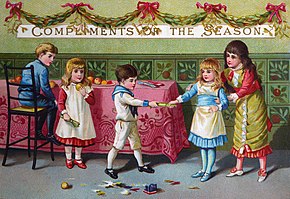
Children depicted pulling a Christmas cracker in a 19th century English Christmas carte
Christmas traditions include a variety of customs, religious practices, rituals, and sociology associated with the commemoration of Christmas. Many of these traditions vary by country or region, while others are universal and practiced in a nigh ubiquitous manner across the world.
Traditions associated with the Christmas holiday are various in their origins and nature, with some traditions comprising an exclusively Christian religious character with origins from within the religion, while others have been described as more than cultural or secular in nature and have originated from outside the realm of Christian influence. Christmas traditions have likewise changed and evolved significantly in the centuries since Christmas was first instituted equally a holiday, with celebrations ofttimes taking on an entirely different quality or atmosphere depending on the time period and geographical region.
History [edit]
Christmas is a holiday since it has evolved over the passage of fourth dimension and many of its cultures take enriched the festivity giving information technology with traditions a key commemoration of the event.
Church attendance [edit]
Christmas Day (inclusive of its vigil eves of religious celebrations vigil, Christmas Eve), is a Festival in the Lutheran Church, a Solemnity in the Roman Catholic Church, and a Principal Banquet of the Anglican Communion. Other Christian denominations practise not rank their feast days but still place importance on Christmas Eve/Christmas Mean solar day, as with other Christian feasts like Easter, Rise Twenty-four hours, and Pentecost.[1] As such, for Christians, attending a Christmas Eve or Christmas Day church service plays an important role in the recognition of the Christmas season. Christmas, along with Easter, is the period of highest almanac church attendance. A 2010 survey past Lifeway Christian Resource found that half-dozen in ten Americans attend church services during this time.[two] In the United Kingdom, the Church of England reported an estimated attendance of 2.5 million people at Christmas services in 2015.[three]
Decorations [edit]

A typical Neapolitan presepe or presepio, or Nascence scene. Local crèches are renowned for their ornate decorations and symbolic figurines, frequently mirroring daily life.
The do of putting upwardly special decorations at Christmas has a long history. In the 15th century, information technology was recorded that in London it was the custom at Christmas for every firm and all the parish churches to be "decked with holm, ivy, bays, and whatsoever the flavor of the twelvemonth afforded to be dark-green".[4] The center-shaped leaves of ivy were said to symbolize the coming to earth of Jesus, while holly was seen equally protection against pagans and witches, its thorns and red berries held to stand for the Crown of Thorns worn by Jesus at the crucifixion and the blood he shed.[5] [6]
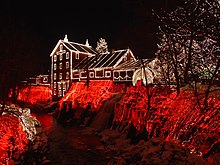
Clifton Mill in Clifton, Ohio is the site of this Christmas display with over three.v million lights.
Nativity scenes are known from 10th-century Rome. They were popularised by Saint Francis of Assisi from 1223, quickly spreading across Europe.[seven] Different types of decorations developed across the Christian world, dependent on local tradition and available resource, and can vary from unproblematic representations of the crib to far more elaborate sets – renowned manger scene traditions include the colourful Kraków szopka in Poland,[viii] which imitate Kraków'southward historical buildings as settings, the elaborate Italian presepi (Neapolitan, Genoese and Bolognese),[nine] [x] [xi] [12] or the Provençal crèches in southern France, using hand-painted terra cotta figurines called santons.[13] In certain parts of the world, notably Sicily, living nativity scenes following the tradition of Saint Francis are a popular alternative to static crèches.[14] [15] [xvi] The showtime commercially produced decorations appeared in Deutschland in the 1860s, inspired by paper chains made by children.[17] In countries where a representation of the Nascency scene is very popular, people are encouraged to compete and create the well-nigh original or realistic ones. Inside some families, the pieces used to make the representation are considered a valuable family heirloom.
The traditional colors of Christmas decorations are reddish, green, and gilt. Red symbolizes the blood of Jesus, which was shed in his crucifixion, while greenish symbolizes eternal life, and in item the evergreen tree, which does not lose its leaves in the winter, and golden is the beginning colour associated with Christmas, every bit i of the 3 gifts of the Magi, symbolizing royalty.[half-dozen]
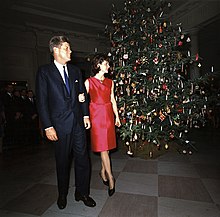
The official White House Christmas tree for 1962, displayed in the Anteroom and presented by John F. Kennedy and his wife Jackie.
The Christmas tree was first used by German Lutherans in the 16th century, with records indicating that a Christmas tree was placed in the Cathedral of Strassburg in 1539, under the leadership of the Protestant Reformer, Martin Bucer.[18] [19] In the United States, these "German Lutherans brought the decorated Christmas tree with them; the Moravians put lighted candles on those trees."[20] [21] When decorating the Christmas tree, many individuals place a star at the summit of the tree symbolizing the Star of Bethlehem, a fact recorded by The School Periodical in 1897.[22] [23] Professor David Albert Jones of Oxford University writes that in the 19th century, it became popular for people to also apply an angel to acme the Christmas tree in lodge to symbolize the angels mentioned in the accounts of the Birth of Jesus.[24] The Christmas tree is considered past some every bit Christianisation of infidel tradition and ritual surrounding the Winter Solstice, which included the utilise of evergreen boughs, and an adaptation of infidel tree worship;[25] co-ordinate to 8th-century biographer Æddi Stephanus, Saint Boniface (634–709), who was a missionary in Frg, took an axe to an oak tree defended to Thor and pointed out a fir tree, which he stated was a more plumbing fixtures object of reverence considering it pointed to heaven and it had a triangular shape, which he said was symbolic of the Trinity.[26] The English language phrase "Christmas tree" is offset recorded in 1835[27] and represents an importation from the German language linguistic communication.[25] [28] [29]
From Federal republic of germany the custom was introduced to Britain, start via Queen Charlotte, married woman of George III, and and then more successfully past Prince Albert during the reign of Queen Victoria. By 1841 the Christmas tree had become even more widespread throughout Britain.[30] Past the 1870s, people in the The states had adopted the custom of putting up a Christmas tree.[31] Christmas trees may be busy with lights and ornaments.
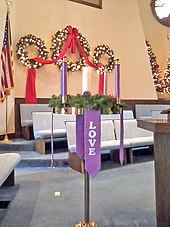
Since the 16th century, the poinsettia, a native constitute from Mexico, has been associated with Christmas conveying the Christian symbolism of the Star of Bethlehem; in that state it is known in Spanish equally the Flower of the Holy Night.[32] [33] Other popular holiday plants include holly, mistletoe, blood-red amaryllis, and Christmas cactus. Along with a Christmas tree, the interior of a abode may exist busy with these plants, forth with garlands and evergreen foliage. The display of Christmas villages has also get a tradition in many homes during this season. The exterior of houses may be decorated with lights and sometimes with illuminated sleighs, snowmen, and other Christmas figures. Mistletoe features prominently in European myth and folklore (for case the legend of Baldr), it is an evergreen parasitic plant which grows on trees, especially apple and poplar, and turns aureate when information technology is dried. It is customary to hang a sprig of mistletoe in the house at Christmas, and anyone standing underneath it may be kissed. Mistletoe has sticky white berries, 1 of which was traditionally removed whenever someone was kissed under it. This is probably a fertility ritual. The mistletoe berry juice resembles semen.[34]

Outdoor Christmas decoration and lighting
Other traditional decorations include bells, candles, processed canes, stockings, wreaths, and angels. Both the displaying of wreaths and candles in each window are a more traditional Christmas brandish. The concentric assortment of leaves, usually from an evergreen, make up Christmas wreaths and are designed to ready Christians for the Advent season. Candles in each window are meant to demonstrate the fact that Christians believe that Jesus Christ is the ultimate low-cal of the world.[35]
Christmas lights and banners may be hung along streets, music played from speakers, and Christmas trees placed in prominent places.[36] It is mutual in many parts of the world for town squares and consumer shopping areas to sponsor and display decorations. Rolls of brightly colored newspaper with secular or religious Christmas motifs are manufactured for the purpose of wrapping gifts. In some countries, Christmas decorations are traditionally taken downwardly on Twelfth Night.
Nativity play [edit]

For the Christian commemoration of Christmas, the viewing of the Nativity play is i of the oldest Christmastime traditions, with the showtime reenactment of the Nativity of Jesus taking identify in A.D. 1223.[37] In that yr, Francis of Assisi assembled a Nativity scene outside of his church in Italy and children sang Christmas carols celebrating the nativity of Jesus.[37] Each twelvemonth, this grew larger and people travelled from distant to run across Francis' depiction of the Nativity of Jesus that came to characteristic drama and music.[37] Nativity plays somewhen spread throughout all of Europe, where they remain pop. Christmas Eve and Christmas Mean solar day church building services oftentimes came to feature Nativity plays, as did schools and theatres.[37] In France, Federal republic of germany, Mexico and Espana, Birth plays are often reenacted outdoors in the streets.[37]
Music and carols [edit]
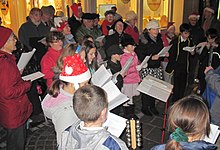
The earliest extant specifically Christmas hymns appear in fourth-century Rome. Latin hymns such every bit "Veni redemptor gentium", written by Ambrose, Archbishop of Milan, were austere statements of the theological doctrine of the Incarnation in opposition to Arianism. "Corde natus ex Parentis" ("Of the Begetter'south honey begotten") by the Spanish poet Prudentius (d. 413) is however sung in some churches today.[38] In the 9th and 10th centuries, the Christmas "Sequence" or "Prose" was introduced in North European monasteries, developing nether Bernard of Clairvaux into a sequence of rhymed stanzas. In the 12th century the Parisian monk Adam of St. Victor began to derive music from popular songs, introducing something closer to the traditional Christmas carol.
By the 13th century, in France, Germany, and particularly, Italy, under the influence of Francis of Assisi, a stiff tradition of pop Christmas songs in the native language adult.[39] Christmas carols in English beginning appear in a 1426 work of John Awdlay, a Shropshire clergyman, who lists twenty-5 "caroles of Cristemas", probably sung past groups of wassailers, who went from business firm to firm.[twoscore]

The songs now known specifically as carols were originally communal folk songs sung during celebrations such as "harvest tide" likewise as Christmas. It was merely subsequently that carols began to be sung in church. Traditionally, carols take often been based on medieval chord patterns, and it is this that gives them their uniquely characteristic musical audio. Some carols similar "Personent hodie", "Good King Wenceslas", and "The Holly and the Ivy" can be traced direct back to the Middle Ages. They are among the oldest musical compositions still regularly sung. "Adeste Fideles" (O Come up all ye faithful) appears in its current form in the mid-18th century, although the words may take originated in the 13th century.
Singing of carols initially suffered a decline in popularity after the Protestant Reformation in northern Europe, although some Reformers, like Martin Luther, wrote carols and encouraged their use in worship. Carols largely survived in rural communities until the revival of interest in popular songs in the 19th century. The 18th-century English reformer Charles Wesley understood the importance of music to worship. In addition to setting many psalms to melodies, which were influential in the Bang-up Awakening in the United States, he wrote texts for at least three Christmas carols. The best known was originally entitled "Hark! How All the Welkin Rings", later renamed "Hark! the Herald Angels Sing".[41]
Felix Mendelssohn wrote a tune adapted to fit Wesley's words. In Austria in 1818 Mohr and Gruber made a major addition to the genre when they composed "Silent Night" for the St. Nicholas Church, Oberndorf. William Sandys' Christmas Carols Ancient and Mod (1833) contained the outset appearance in impress of many now-classic English carols, and contributed to the mid-Victorian revival of the festival.[42]
Completely secular Christmas seasonal songs emerged in the late 18th century. "Deck the Halls" dates from 1784, and the American "Jingle Bells" was copyrighted in 1857. In the 19th and 20th century, African American spirituals and songs nearly Christmas, based in their tradition of spirituals, became more widely known. An increasing number of seasonal holidays songs were commercially produced in the 20th century, including jazz and dejection variations. In improver, there was a revival of interest in early music, from groups singing folk music, such as The Revels, to performers of early medieval and classical music. John Rutter has composed many carols including "All Bells in Paradise", "Angels' Carol", "Candlelight Carol", "Ass Carol", "Jesus Kid", "Shepherd's Pipe Carol" and "Star Carol".
Traditional cuisine [edit]
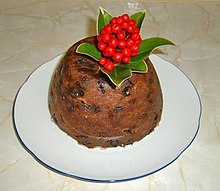
A special Christmas family unit meal is traditionally an of import part of the vacation's celebration, and the food that is served varies greatly from state to country. Some regions have special meals for Christmas Eve, such as Sicily, where 12 kinds of fish are served. In the U.k. and countries influenced by its traditions, a standard Christmas meal includes turkey, goose or other large bird, gravy, potatoes, vegetables, sometimes breadstuff and cider. Special desserts are also prepared, such as Christmas pudding, mince pies, fruit cake and Yule log cake.[43] [44]
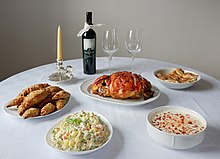
Christmas table in Serbia
In Poland and other parts of eastern Europe and Scandinavia, fish often is used for the traditional primary course, but richer meat such equally lamb is increasingly served. In Sweden information technology is common with a special diverseness of smörgåsbord, where ham, meatballs and herring play a prominent role. In Deutschland, France, and Austria, goose and pork are favored. Beef, ham, and chicken in various recipes are pop throughout the globe. The Maltese traditionally serve Imbuljuta tal-Qastan,[45] a chocolate and chestnuts beverage, after Midnight Mass and throughout the Christmas season. Slovenes prepare the traditional Christmas bread potica, bûche de Noël in French republic, panettone in Italian republic, and elaborate tarts and cakes. The eating of sweets and chocolates has become pop worldwide, and sweeter Christmas delicacies include the German language stollen, marzipan cake or candy, and Jamaican rum fruit cake. Equally one of the few fruits traditionally available to northern countries in winter, oranges have been long associated with special Christmas foods. Eggnog is a sweetened dairy-based drink traditionally made with milk, foam, carbohydrate, and whipped eggs (which gives it a frothy texture). Spirits such as brandy, rum or bourbon are often added. The finished serving is frequently garnished with a sprinkling of basis cinnamon or nutmeg.
Cards [edit]
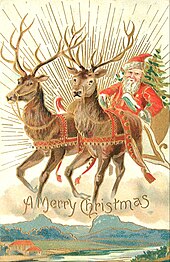
A 1907 Christmas carte with Santa and some of his reindeer
Christmas cards are illustrated messages of greeting exchanged between friends and family members during the weeks preceding Christmas 24-hour interval. The traditional greeting reads "wishing y'all a Merry Christmas and a Happy New Twelvemonth", much similar that of the first commercial Christmas card, produced by Sir Henry Cole in London in 1843.[46] The custom of sending them has become popular among a wide cross-department of people with the emergence of the modern trend towards exchanging E-cards.
Christmas cards are purchased in considerable quantities, and feature artwork, commercially designed and relevant to the season. The content of the design might relate direct to the Christmas narrative, with depictions of the Nativity of Jesus, or Christian symbols such as the Star of Bethlehem, or a white dove, which can represent both the Holy Spirit and Peace on World. Other Christmas cards are more secular and can describe Christmas traditions, mythical figures such as Santa Claus, objects directly associated with Christmas such as candles, holly and baubles, or a variety of images associated with the flavour, such every bit Christmastide activities, snow scenes and the wild animals of the northern winter. There are fifty-fifty humorous cards and genres depicting nostalgic scenes of the past such as crinolined shoppers in idealized 19th-century streetscapes.
Some prefer cards with a poem, prayer, or Biblical verse; while others altitude themselves from organized religion with an all-inclusive "Flavour's greetings".
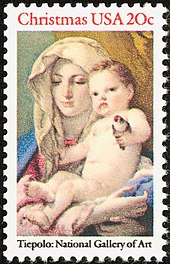
Commemorative stamps [edit]
A number of nations have issued commemorative stamps at Christmastide. Postal customers will often use these stamps to postal service Christmas cards, and they are popular with philatelists. These stamps are regular postage stamps, unlike Christmas seals, and are valid for postage year-round. They usually go along sale some time betwixt early on Oct and early December, and are printed in considerable quantities.
Gift giving [edit]

Christmas gifts under a Christmas tree
The exchanging of gifts is one of the cadre aspects of the modern Christmas celebration, making it the most profitable time of year for retailers and businesses throughout the world. On Christmas, people exchange gifts based on the Christian tradition associated with Saint Nicholas,[47] and the gifts of gilded, frankincense, and myrrh which were given to the babe Jesus by the Magi.[48] [49] The exercise of souvenir giving in the Roman celebration of Saturnalia may have influenced Christian Christmas customs, just on the other hand the Christian "cadre dogma of the Incarnation, nevertheless, solidly established the giving and receiving of gifts every bit the structural principle of that recurrent all the same unique consequence", because it was the Biblical Magi, "together with all their fellow men, who received the souvenir of God through human'due south renewed participation in the divine life."[50]
Gift-bearing figures [edit]
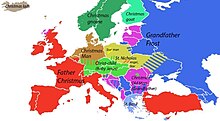
Christmas gift-bringers in Europe
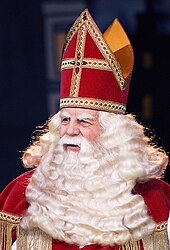
A number of figures are associated with Christmas and the seasonal giving of gifts. Among these are Father Christmas, too known every bit Santa Claus (derived from the Dutch for Saint Nicholas), Père Noël, and the Weihnachtsmann; Saint Nicholas or Sinterklaas; the Christkind; Kris Kringle; Joulupukki; tomte/nisse; Babbo Natale; Saint Basil; and Ded Moroz. The Scandinavian tomte (also chosen nisse) is sometimes depicted every bit a gnome instead of Santa Claus.
The best known of these figures today is red-dressed Santa Claus, of diverse origins. The proper noun Santa Claus can be traced dorsum to the Dutch Sinterklaas, which means but Saint Nicholas. Nicholas was a fourth-century Greek bishop of Myra, a urban center in the Roman province of Lycia, whose ruins are 3 kilometres (one.ix mi) from modernistic Demre in southwest Turkey.[52] [53] Among other saintly attributes, he was noted for the care of children, generosity, and the giving of gifts. His feast day, Dec six, came to exist historic in many countries with the giving of gifts.[54]
Saint Nicholas traditionally appeared in bishop's attire, accompanied by helpers, inquiring nigh the behaviour of children during the past year earlier deciding whether they deserved a gift or non. By the 13th century, Saint Nicholas was well known in holland, and the practice of gift-giving in his proper noun spread to other parts of central and southern Europe. During the Reformation in 16th–17th-century Europe, many Protestants changed the gift bringer to the Christ Child or Christkindl, corrupted in English to Kris Kringle, and the appointment of giving gifts changed from December 6 to Christmas Eve.[54]
The modern popular image of Santa Claus, however, was created in the United States, and in particular in New York. The transformation was accomplished with the aid of notable contributors including Washington Irving and the German-American cartoonist Thomas Nast (1840–1902). Following the American Revolutionary War, some of the inhabitants of New York Urban center sought out symbols of the city's non-English language past. New York had originally been established equally the Dutch colonial town of New Amsterdam and the Dutch Sinterklaas tradition was reinvented equally Saint Nicholas.[55]
In 1809, the New-York Historical Society convened and retroactively named Sancte Claus the patron saint of Nieuw Amsterdam, the Dutch name for New York City.[56] At his showtime American appearance in 1810, Santa Claus was drawn in bishops' robes. Nevertheless, as new artists took over, Santa Claus developed more than secular attire.[57] Nast drew a new image of "Santa Claus" annually, beginning in 1863. By the 1880s, Nast's Santa had evolved into the modern vision of the figure, perhaps based on the English figure of Father Christmas. The image was standardized by advertisers in the 1920s[58] and continues through the present day.[59] [60]
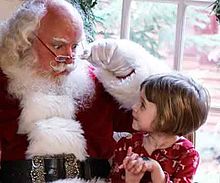
Father Christmas, a jolly, stout, bearded man who typified the spirit of good cheer at Christmas, predates the Santa Claus character. He is start recorded in early 17th century England, but was associated with holiday merrymaking and drunkenness rather than the bringing of gifts.[27] In Victorian Britain, his epitome was remade to match that of Santa. The French Père Noël evolved along similar lines, eventually adopting the Santa image. In Italy, Babbo Natale acts equally Santa Claus, while La Befana is the bringer of gifts and arrives on the eve of the Epiphany. It is said that La Befana ready out to bring the infant Jesus gifts, but got lost along the fashion. Now, she brings gifts to all children. In some cultures Santa Claus is accompanied past Knecht Ruprecht, or Black Peter. In other versions, elves make the toys. His married woman is referred to as Mrs. Claus.
There has been some opposition to the narrative of the American evolution of Saint Nicholas into the modern Santa. It has been claimed that the Saint Nicholas Club was non founded until 1835, almost half a century after the finish of the American War of Independence.[61] Moreover, a study of the "children'due south books, periodicals and journals" of New Amsterdam by Charles Jones revealed no references to Saint Nicholas or Sinterklaas.[62] Withal, non all scholars agree with Jones's findings, which he reiterated in a book-length report in 1978;[63] Howard Thousand. Hageman, of New Brunswick Theological Seminary, maintains that the tradition of jubilant Sinterklaas in New York was live and well from the early settlement of the Hudson Valley on.[64]
Current tradition in several Latin American countries (such as Venezuela and Colombia) holds that while Santa makes the toys, he and then gives them to the Baby Jesus, who is the one who really delivers them to the children's homes, a reconciliation between traditional religious beliefs and the iconography of Santa Claus imported from the United States.
In South Tyrol (Italian republic), Austria, Czechia, Southern Germany, Hungary, Liechtenstein, Slovakia, and Switzerland, the Christkind (Ježíšek in Czech, Jézuska in Hungarian and Ježiško in Slovak) brings the presents. Greek children go their presents from Saint Basil on New Year's Eve, the eve of that saint's liturgical banquet.[65] The German St. Nikolaus is not identical with the Weihnachtsmann (who is the German version of Santa Claus / Father Christmas). St. Nikolaus wears a bishop'southward apparel and still brings small gifts (commonly candies, basics, and fruits) on December half dozen and is accompanied by Knecht Ruprecht. Although many parents around the world routinely teach their children near Santa Claus and other souvenir bringers, some have come to decline this practice, because information technology deceptive.[66]
Multiple gift-giver figures be in Poland, varying betwixt regions and individual families. St Nicholas (Święty Mikołaj) dominates Central and N-East areas, the Starman (Gwiazdor) is most mutual in Greater Poland, Baby Jesus (Dzieciątko) is unique to Upper Silesia, with the Little Star (Gwiazdka) and the Picayune Angel (Aniołek) beingness mutual in the South and the South-East. Grandpa Frost (Dziadek Mróz) is less unremarkably accustomed in some areas of Eastern Poland.[67] [68] It is worth noting that beyond all of Poland, St Nicholas is the souvenir giver on the Saint Nicholas 24-hour interval on Dec half dozen.
References [edit]
- ^ "2018 Worship and Music Planning Calendar". The United Methodist Church building. 2018. Retrieved December ix, 2018.
- ^ Setzer, Ed (December 14, 2015). "What Is Church Attendance Like During Christmastime? New Information From Lifeway Research". Christianity Today. Archived from the original on Jan 29, 2018. Retrieved Dec 9, 2018.
- ^ Bingham, John (Oct 27, 2016). "British families merely attend church at Christmas, new figures suggest". The Daily Telegraph. Archived from the original on December 27, 2017. Retrieved December 24, 2017.
- ^ Miles, Clement A, Christmas customs and traditions, Courier Dover Publications, 1976, ISBN 0-486-23354-5, p. 272.
- ^ Heller, Ruth, Christmas: Its Carols, Customs & Legends, Alfred Publishing (1985), ISBN 0-7692-4399-1, p. 12.
- ^ a b Collins, Ace (April 1, 2010). Stories Behind the Peachy Traditions of Christmas. Zondervan. ISBN978-0-310-87388-4 . Retrieved Dec ii, 2010.
- ^ Collins, Ace, Stories Behind the Great Traditions of Christmas, Zondervan, (2003), ISBN 0-310-24880-9 p.47.
- ^ Internet Archive Susan Topp Weber, Nativities of the World, Gibbs Smith, 2013
- ^ "Alla scoperta dei cinque presepi più belli di Bologna | Nuok". Nuok.it. January 24, 2013. Archived from the original on December 27, 2013. Retrieved December 25, 2013.
- ^ "Presepi in Liguria: provincia di Genova, Tigullio -sito di Paolino". Digilander.libero.it. Archived from the original on Dec 27, 2013. Retrieved December 25, 2013.
- ^ "Holidays at the Museums : Carnegie Museum of Natural History". Carnegiemnh.org. November 26, 2013. Archived from the original on December 27, 2013. Retrieved December 25, 2013.
- ^ Bershad, David; Carolina Mangone, The Christian Travelers Guide to Italy, Zondervan, 2001.
- ^ "The Provençal Birth Scene". Simplytreasures.com. Archived from the original on September 14, 2012. Retrieved Dec 25, 2013.
- ^ Seaburg, Carl, Celebrating Christmas: An Anthology, iUniverse, 2003.
- ^ Bowler, Gerry, The Globe Encyclopedia of Christmas, Random House LLC, 2012.
- ^ Carol King (December 24, 2012). "A Christmas Living Nativity Scene in Sicily". Italy Magazine. Archived from the original on December 26, 2013. Retrieved Dec 25, 2013.
- ^ Collins p. 83.
- ^ Senn, Frank C. (2012). Introduction to Christian Liturgy. Fortress Press. p. 118. ISBN9781451424331.
The Christmas tree as we know it seemed to sally in Lutheran lands in Germany in the sixteenth century. Although no specific city or town has been identified as the outset to take a Christmas tree, records for the Cathedral of Strassburg bespeak that a Christmas tree was set up in that church building in 1539 during Martin Bucer'south superintendency.
- ^ "The Christmas Tree". Lutheran Spokesman. 29–32. 1936.
The Christmas tree became a widespread custom among High german Lutherans past the eighteenth century.
- ^ Kelly, Joseph F. (2010). The Banquet of Christmas. Liturgical Printing. p. 94. ISBN9780814639320.
German Lutherans brought the decorated Christmas tree with them; the Moravians put lighted candles on those trees.
- ^ Blainey, Geoffrey (October 24, 2013). A Curt History of Christianity. Rowman & Littlefield Publishers. p. 418. ISBN9781442225909.
Many Lutherans continued to fix up a small fir tree as their Christmas tree, and it must have been a seasonal sight in Bach'southward Leipzig at a time when it was about unknown in England, and petty known in those farmlands of North America where Lutheran immigrants congregated.
- ^ Mandryk, DeeAnn (October 25, 2005). Canadian Christmas Traditions. James Lorimer & Company. p. 67. ISBN9781554390984.
The eight-pointed star became a popular manufactured Christmas decoration around the 1840s and many people identify a star on the top of their Christmas tree to represent the Star of Bethlehem.
- ^ Wells, Dorothy (1897). "Christmas in Other Lands". The School Journal. 55: 697–8.
Christmas is the occasional of family reunions. Grandmother always has the place of honor. As the fourth dimension approaches for enjoying the tree, she gathers her grandchildren about her, to tell them the story of the Christ child, with the meaning of the Christ child, with the pregnant of the Christmas tree; how the evergreen is meant to represent the life everlasting, the candle lights to call back the low-cal of the globe, and the star at the tiptop of the tree is to remind them of the star of Bethlehem.
- ^ Jones, David Albert (October 27, 2011). Angels. Oxford University Press. p. 24. ISBN9780191614910.
The aforementioned ambiguity is seen in that most familiar of angels, the angel on superlative of the Christmas tree. This decoration, popularized in the nineteenth century, recalls the place of the angels in the Christmas story (Luke two.nine–eighteen).
- ^ a b van Renterghem, Tony. When Santa was a shaman. St. Paul: Llewellyn Publications, 1995. ISBN one-56718-765-X.
- ^ Fritz Allhoff, Scott C. Lowe (2010). Christmas. John Wiley & Sons.
His biographer, Eddius Stephanus, relates that while Boniface was serving every bit a missionary near Geismar, Germany, he had enough of the locals' reverence for the old gods. Taking an axe to an oak tree dedicated to Norse god Thor, Boniface chopped the tree downwards and dared Thor to zap him for it. When cipher happened, Boniface pointed out a young fir tree amid the roots of the oak and explained how this tree was a more plumbing fixtures object of reverence as information technology pointed towards the Christian heaven and its triangular shape was reminiscent of the Christian trinity.
- ^ a b Harper, Douglas, Christ Archived May 9, 2006, at the Wayback Machine, Online Etymology Dictionary, 2001.
- ^ "The Chronological History of the Christmas Tree". The Christmas Archives. Archived from the original on December 21, 2007. Retrieved December xviii, 2007.
- ^ "Christmas Tradition – The Christmas Tree Custom". Fashion Era. Archived from the original on Dec xviii, 2007. Retrieved Dec eighteen, 2007.
- ^ Lejeune, Marie Claire. Compendium of symbolic and ritual plants in Europe, p.550. Academy of Michigan ISBN 90-77135-04-9.
- ^ Shoemaker, Alfred Lewis. (1959) Christmas in Pennsylvania: a folk-cultural study. Edition 40. pp. 52, 53. Stackpole Books 1999. ISBN 0-8117-0328-2.
- ^ Hewitson, Carolyn (2013). Festivals. Routledge. ISBN9781135057060.
It is said to resemble the star of Bethlehem. The Mexicans call it the flower of the Holy Night, but unremarkably it is called poinsettia after the man who introduced it to America, Dr Joel Poinsett.
- ^ "The Legends and Traditions of Vacation Plants". www.ipm.iastate.edu. Archived from the original on January 22, 2016. Retrieved February 17, 2016.
- ^ "Mistletoe Traditions". The Mistletoe Pages. Archived from the original on December 25, 2017. Retrieved December 24, 2017.
- ^ "Liturgical Yr : Symbolic Lights and Fires of Christmas (Activity)". Catholic Civilisation. Archived from the original on Jan 13, 2012. Retrieved December 10, 2011.
- ^ Murray, Brian. "Christmas lights and community edifice in America," History Matters, Spring 2006. Archived June 29, 2010, at the Wayback Machine
- ^ a b c d eastward Collins, Ace (2010). Stories Behind the Great Traditions of Christmas. Zondervan. pp. 139–141. ISBN9780310873884.
- ^ Miles, Clement, Christmas customs and traditions, Courier Dover Publications, 1976, ISBN 0-486-23354-5, p. 32.
- ^ Miles, pp. 31–37.
- ^ Miles, pp. 47–48.
- ^ Dudley-Smith, Timothy (1987). A Flame of Love. London: Triangle/SPCK. ISBN978-0-281-04300-ii.
- ^ Richard Michael Kelly. A Christmas Carol, Broadview Press, 2003, p. ten. ISBN 1-55111-476-3.
- ^ Broomfield, Andrea (2007), Nutrient and Cooking in Victorian England: A History, Greenwood Publishing Grouping, 2007, pp. 149–150.
- ^ Muir, Frank (1977), Christmas customs & traditions, Taplinger Pub. Co., 1977, p. 58.
- ^ "Imbuljuta". Schoolnet.gov.mt. Archived from the original on January 22, 2012. Retrieved Feb 3, 2012.
- ^ "Christmas menu sold for record cost" Archived February five, 2006, at the Wayback Machine, BBC News. Retrieved October 28, 2011.
- ^ Collins, Ace (April 20, 2010). Stories Behind the Great Traditions of Christmas. Zondervan. p. 17. ISBN9780310873884 . Retrieved April x, 2012.
The legend of St. Nicholas, who became the bishop of Myra in the commencement of the 4th century, is the adjacent link in the Christmas-gift chain. Fable has information technology that during his life the priest rode across Asia Minor bestowing gifts upon poor children.
- ^ Trexler, Richard (May 23, 1997). The Journey of the Magi: Meanings in History of a Christian Story. Princeton University Printing. p. 17. ISBN978-0691011264. Archived from the original on December 31, 2015. Retrieved Apr x, 2012.
This exchange network of ceremonial welcome was mirrored in a second reciprocity allowing early Christians to imagine their ain magi: the miracle of giving gifts.
- ^ Collins, Ace (April xx, 2010). Stories Behind the Great Traditions of Christmas. Zondervan. p. 17. ISBN9780310873884 . Retrieved April 10, 2012.
Well-nigh people today trace the practice of giving gifts on Christmas Day to the 3 gifts that the Magi gave to Jesus.
- ^ Berking, Helmuth (March 30, 1999). Sociology of Giving. SAGE Publications. p. 14. ISBN978-0-85702-613-2.
For the Enlightenment educationalist, gift-giving turned out to exist a relic of a pagan custom, namely, the Roman Saturnalia. After the introduction of the Julian calendar in Rome, the 25th of December became the day of Sol invictus when people greeted the wintertime solstice. It was the day of the Sun's rebirth, and it was the twenty-four hour period of the Christmas festivities – although information technology was only in the yr 336 Ad that it appears to have become established as the day of Jesus's birth (meet Pannenberg 1989: 57). The Eastern Church adopted this date even later, towards the stop of the 4th century, having previously regarded the sixth of January as the mean solar day of gift-giving, as information technology all the same is in the Italian community of Befana. The winter solstice was a time of festivity in every traditional civilisation, and the Christian Christmas probably took its place within this mythical context of the solar cult. Its core dogma of the Incarnation, even so, solidly established the giving and receiving of gifts equally the structural principle of that recurrent yet unique event. 'Children were given presents as the Jesus child received gifts from the magi or kings who came from afar to admire him. But in reality information technology was they, together with all their boyfriend men, who received the souvenir of God through man's renewed participation in the divine life' (ibid.: 61).
- ^ Seward, Pat; Lal, Sunandini Arora (2006). Netherlands. Marshall Cavendish. p. 116. ISBN978-0-7614-2052-1.
Until quite recently, the celebrations focused solely on Saint Nicholas, or Sinterklaas (SIN-ter-klahs), as the Dutch call him. ... Interestingly, the American Santa Claus was built-in out of the Dutch Sinterklaas.
- ^ Domenico, Roy Palmer (2002). The regions of Italy: a reference guide to history and culture . Greenwood Publishing Grouping. p. 21. ISBN978-0-313-30733-i.
Saint Nicholas (Bishop of Myra) replaced Sabino as the patron saint of the city... A Greek from what is now Turkey, he lived in the early fourth century.
- ^ Collins, Ace (2009). Stories Behind Men of Organized religion . Zondervan. p. 121. ISBN978-0-310-56456-0 . Retrieved June xx, 2015.
Nicholas was built-in in the Greek city of Patara around 270 AD. The son of a businessman named Theophanes and his wife, Nonna, the child's earliest years were spent in Myra... As a port on the Mediterranean Sea, in the middle of the sea lanes that linked Egypt, Greece and Rome, Myra was a destination for traders, fishermen, and merchant sailors. Spawned by the spirit of both the city's Greek heritage and the ruling Roman government, cultural endeavours such equally art, drama, and music were mainstays of everyday life.
- ^ a b Forbes, Bruce David, Christmas: a aboveboard history, University of California Press, 2007, ISBN 0-520-25104-0, pp. 68–79.
- ^ Jona Lendering (November 20, 2008). "Saint Nicholas, Sinterklaas, Santa Claus". Livius.org. Archived from the original on May 13, 2011. Retrieved February 24, 2011.
- ^ John Steele Gordon, The Cracking Game: The Emergence of Wall Street as a World Power: 1653–2000 (Scribner), 1999.
- ^ Forbes, Bruce David, Christmas: A Aboveboard History, pp. 80–81.
- ^ Mikkelson, Barbara and David P., "The Claus That Refreshes" Archived December 1, 2005, at Archive-It, Snopes.com, 2006.
- ^ Win Rosenfeld (Dec 25, 2007). "America'south Side by side Height Santa". NPR. Archived from the original on Dec 25, 2013. Retrieved Nov 22, 2012.
Father Christmas – merely this Santa also goes by the proper noun Jonathan Meath....
- ^ Mary Ann Georgantopoulos (December 25, 2007). "Miracle on Mass. Ave.: City Santa takes accommodate seriously". Boston Globe. Archived from the original on December 25, 2013. Retrieved Nov 22, 2012.
Meath, who is in his starting time year of existence a full-time Santa, makes appearances around Massachusetts at places such as Swing City in Newton....
- ^ "History of the Society". The Saint Nicholas Society of the Metropolis of New York. Archived from the original on January 6, 2009. Retrieved Dec v, 2008.
- ^ Jones, Charles West. "Knickerbocker Santa Claus". The New-York Historical Lodge Quarterly. Vol. XXXVIII, no. four.
- ^ Jones, Charles W., Saint Nicholas of Myra, Bari, and Manhattan: Biography of a Legend (Chicago: University of Chicago Printing, 1978).
- ^ Hageman, Howard K. (1979). "Review of Saint Nicholas of Myra, Bari, and Manhattan: Biography of a Legend". Theology Today. Vol. 36, no. 3. Princeton: Princeton Theological Seminary. Archived from the original on Dec 7, 2008. Retrieved Dec v, 2008.
- ^ "St. Basil (330–379)". Skiathosbooks.com. Archived from the original on January 12, 2012. Retrieved Feb 3, 2012.
- ^ Matera, Mariane. "Santa: The First Great Prevarication" Archived September 14, 2007, at the Wayback Machine, Citybeat, Upshot 304.
- ^ "Kto przynosi Wam prezenty? Św. Mikołaj, Gwiazdor, Aniołek, Dzieciątko czy może Dziadek Mróz?". Bezprawnik (in Polish). December 22, 2016. Archived from the original on December 24, 2017. Retrieved December 24, 2017.
- ^ "Nie tylko Mikołaj, czyli kto według tradycji rozdaje prezenty w różnych regionach Polski?". gazeta.pl (in Polish). Archived from the original on December 24, 2017. Retrieved December 24, 2017.
Source: https://en.wikipedia.org/wiki/Christmas_traditions
0 Response to "what is done to prepare home for christmas in some countries"
Post a Comment